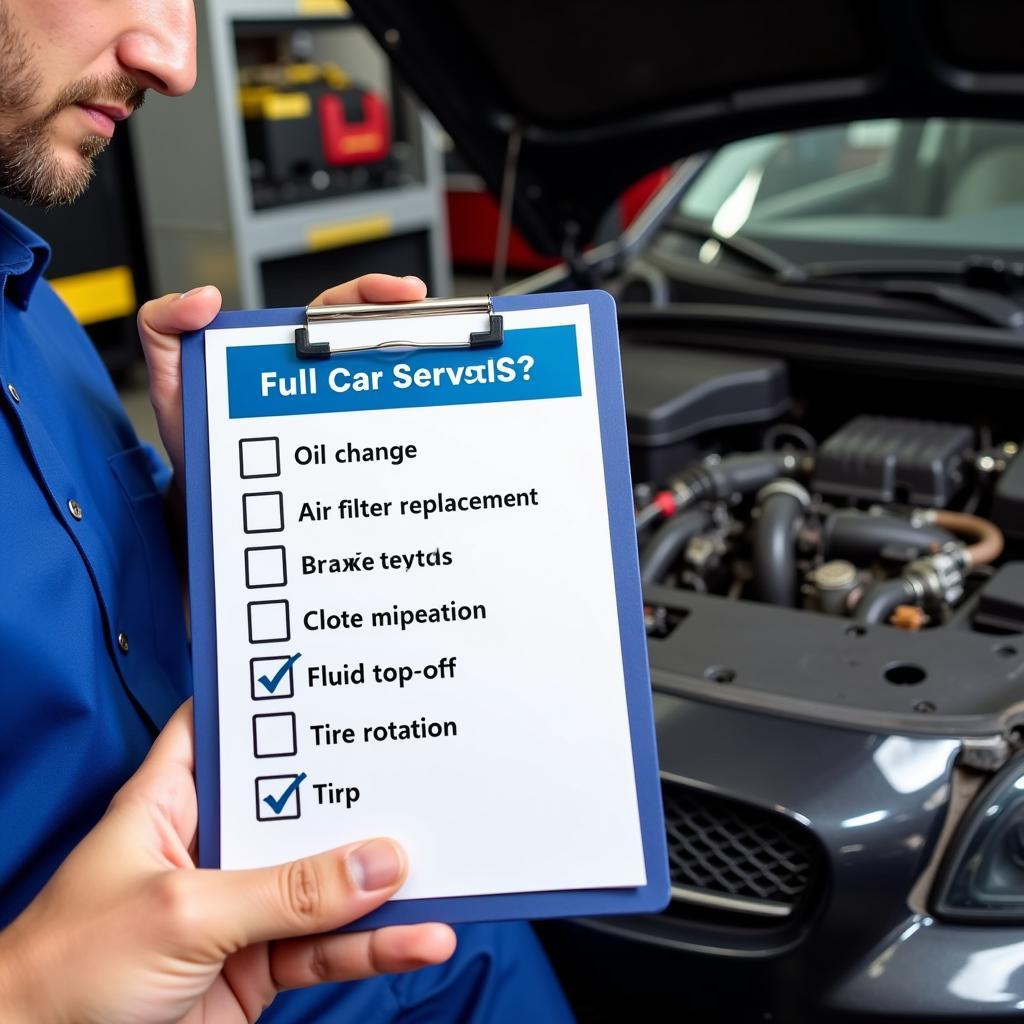How to Do a Full Service on a Car
A full car service is essential for maintaining your vehicle’s performance, safety, and longevity. Knowing How To Do A Full Service On A Car can save you money and give you peace of mind knowing your car is in top condition. This comprehensive guide covers everything you need to know, from essential checks to more advanced maintenance procedures.
Understanding a Full Car Service
A full car service is more comprehensive than a basic service and involves a thorough inspection and maintenance of various car systems. It addresses potential issues before they become major problems. A full service typically includes checks and replacements related to the engine, brakes, suspension, steering, and electrical systems. what do they check in a full car service will give you a deeper understanding of the checks involved.
What’s Included in a Full Car Service?
A full car service typically includes the following checks and services:
- Engine: Oil and filter change, spark plug replacement, air filter replacement, fuel filter replacement, and checking for leaks.
- Brakes: Inspecting brake pads, discs, and fluid levels, and adjusting or replacing components as needed.
- Suspension: Checking shock absorbers, springs, and other components for wear and tear.
- Steering: Inspecting steering components for looseness or damage.
- Electrical System: Checking battery health, lights, and other electrical components.
 Full Car Service Checklist
Full Car Service Checklist
Essential Tools and Supplies
Before beginning your full car service, gather the following tools and supplies:
- Wrenches and Sockets
- Screwdrivers
- Jack and Jack Stands
- Oil Drain Pan
- Funnel
- New Oil and Filter
- New Spark Plugs
- New Air Filter
- New Fuel Filter
- Brake Cleaner
- Other fluids as needed (coolant, brake fluid, power steering fluid)
when does a car need a full service helps you determine the appropriate service intervals for your specific vehicle.
Performing the Full Service
Step-by-Step Guide to a DIY Full Service
This is a general guide and may not cover all vehicle makes and models. Always consult your vehicle’s owner’s manual for specific instructions and recommendations.
- Prepare the Vehicle: Park on a level surface, engage the parking brake, and gather all necessary tools and supplies.
- Drain the Engine Oil: Locate the oil drain plug, place the drain pan underneath, and remove the plug. Allow the oil to drain completely.
- Replace the Oil Filter: Remove the old oil filter and lubricate the gasket of the new filter before installing it.
- Refill the Engine Oil: Replace the oil drain plug and add the recommended amount of new oil. Check the oil level using the dipstick.
- Inspect the Brakes: Remove the wheels and inspect the brake pads and discs for wear. Replace them if necessary. Check and top off brake fluid.
 Brake Pad Inspection during Full Service
Brake Pad Inspection during Full Service
- Check the Suspension: Inspect shock absorbers, springs, and other components for damage or leaks.
- Inspect the Steering System: Check for looseness or damage in the steering components.
- Inspect the Electrical System: Check the battery terminals for corrosion and clean them if necessary. Test the battery voltage and ensure all lights are functioning correctly.
- Replace Air and Fuel Filters: Locate and replace the air and fuel filters according to your vehicle’s owner’s manual.
- Top off Fluids: Check and top off all other fluids, such as coolant, power steering fluid, and windshield washer fluid.
“Regular maintenance, including a full car service, is like preventative medicine for your car. It keeps it running smoothly and prevents costly repairs down the line,” says John Davis, a certified automotive technician with over 20 years of experience. do you tip full service car wash offers insights into tipping etiquette, which, though unrelated to mechanical service, is relevant to the overall car care experience.
Importance of Regular Maintenance
Regular car servicing is crucial for several reasons:
- Safety: A well-maintained car is a safer car. Regular servicing helps identify and address potential safety issues, such as worn brakes or faulty steering components.
- Performance: A full service can improve your car’s performance by ensuring that all systems are functioning optimally.
- Longevity: Regular maintenance can extend the life of your car by preventing premature wear and tear on its components.
- Resale Value: A well-maintained car with a documented service history has a higher resale value.
how much does full service of car cost provides a breakdown of the typical costs involved in a full car service, helping you budget accordingly.
Conclusion
Knowing how to do a full service on a car can be empowering and cost-effective. While this guide provides a comprehensive overview, consulting your vehicle’s owner’s manual and seeking professional help when needed is always recommended. Regular full car services are crucial for ensuring your vehicle’s safety, performance, and longevity.
 Car Maintenance Tools for a Full Service
Car Maintenance Tools for a Full Service
do i need a full car service helps you assess whether your car requires a full service based on its age, mileage, and driving conditions.
“Performing regular maintenance is an investment in your car’s future, saving you money and headaches in the long run,” adds Sarah Miller, a lead mechanic at a reputable auto repair shop.
Need help with your car service? Contact us via WhatsApp: +1(641)206-8880, Email: [email protected] or visit us at 456 Oak Avenue, Miami, FL 33101, USA. Our customer support team is available 24/7.

